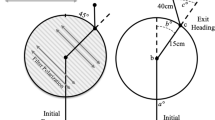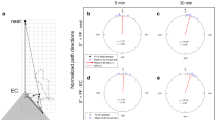Summary
-
1.
Hodotermes workers conduct both day and night harvesting expeditions in the open air.
-
2.
The harvesting direction taken from the foraging hole is determined at the beginning of the foraging period.
-
3.
Two systems of aboveground orientation can be employed: optical menotaxis and pheromonal (chemical) orientation.
-
4.
Optical orientation is more precise than pheromonal orientation. If both parameters are experimentally set in competition, optical cues dominate over pheromonal cues when ever they can be utilized.
-
5.
Pheromonal orientation is crucial in “diffuse-light” or “no-light” conditions. It is always essential in the close vicinity of the foraging hole.
-
6.
The pheromonal source is the sternal gland. A field of pheromonal marks is built up along the main foraging direction. Pheromonal orientation is performed by klinotactic motion along the chemical field.
-
7.
Termites going out from the nest tend to use pheromonal orientation more readily than those returning.
-
8.
In addition to directional orientation, individual memory for the distance between the foraging hole and feeding place has been demonstrated in homing termites.
Similar content being viewed by others
References
Batschelet, E.: Statistical methods for the analysis of problems in animal orientation and certain biological rhythms. Am. Inst. Biol. Sci., Wash. (1965)
Brun, R.: Die Raumorientierung der Ameisen (und das Orientierungsproblem im Allgemeinen). Jena: Gustav Fischer 1914
Coaton, W.G.H.: The hodotermitid harvester termites of South Africa. Sci. Bull. Dep. Agric. Un. S. Afr. 375 (1958)
Cornetz, V.: Les explorations et les voyages des fourmis. Paris: Flammarion 1914
Hadorn, E., Wehner, R.: Allgemeine Zoologie. Dtv Thieme, WR4061 (1971)
Hölldobler, B.: Homing in the harvester ant Pogonomyrmex badius. Science 171, 1149–1151 (1971)
Horstmann, K.: Über die Duftspurorientierung bei Waldameisen (Formica polyctena Foerster). In preparation (1976)
Jander, R.: Die optische Richtungsorientierung der roten Waldameise Formica rufa L. Z. vergl. Physiol. 40, 162–238 (1957)
Jander, R., Daumer, K.: Guide-line and gravity orientation of blind termites foraging in the open (Termitidae: Macrotermes, Hospitalitermes). Insectes soc. 21, 45–69 (1974)
Kaib, M., Leuthold, R.H.: Mechanisms of chemical orientation in Hodotermes mossambicus and Schedorhinotermes lamanianus. In preparation (1976)
Leuthold, R.H.: Orientation of the harvesting termite Hodotermes mossambicus (Hagen). Proc. 7th Congr. IUSSI, London, 244–246 (1973)
Leuthold, R.H., Lüscher, M.: An unusual caste polymorphism of the sternal gland and its trail pheromone production in the termite Trinervitermes bettonianus. Insectes soc. 21, 319–326 (1974)
Santschi, F.: Sur le méchanisme de l'orientation chez les fourmis. Rev. suisse Zool. 19, 303–338 (1911)
Wehner, R., Menzel, R.: Homing in the ant Cataglyphis bicolor. Science 164, 192–194 (1969)
Wilson, E.O.: The insect societies. Cambridge, Mass: Belknap 1971
Author information
Authors and Affiliations
Additional information
c/o O. Bruinsma
Rights and permissions
About this article
Cite this article
Leuthold, R.H., Bruinsma, O. & van Huis, A. Optical and pheromonal orientation and memory for homing distance in the harvester termite Hodotermes mossambicus (Hagen). Behav Ecol Sociobiol 1, 127–139 (1976). https://doi.org/10.1007/BF00299194
Received:
Issue Date:
DOI: https://doi.org/10.1007/BF00299194




